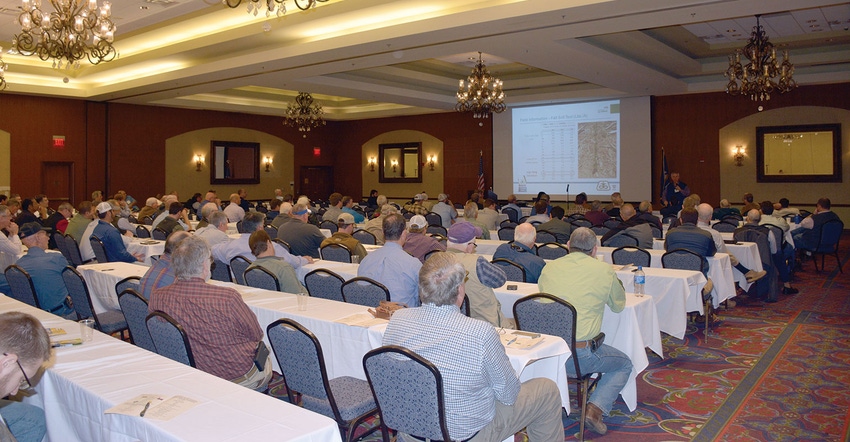
Dicamba has the dubious distinction of being the largest off-target problem ever for a pesticide in the United States.
That problem, says Ples Spradley, pesticide assessment specialist, University of Arkansas Extension, can’t be attributed to application error. “Most weed scientists think the problem is the formulation,” Spradley said during the opening session of the Louisiana Technology and Management Conference in Marksville, La.
The annual conference is sponsored by the Louisiana Agricultural Consultants Association.
Spradley says in early evaluations of the reduced volatility formulations of dicamba university researchers were not allowed to consider volatility. “That was a problem. Reduced volatility claims were based on laboratory and limited field testing.”
He says reduced volatility did not eliminate the potential for vapor drift. “It can move in unpredictable directions.”
No surprise
Not a surprise to experienced weed scientists.
“From the git-go, weed specialists such as Ford Baldwin predicted problems when dicamba was applied to large acreages in the summer heat,” Spradley says.
The new federal label, in effect for 2019, has some positive changes, Spradley says, including a stipulation that only certified pesticide applicators may apply the products and that anyone who applies them must take mandatory training.
Proposed regulations in Arkansas would require a May 21 cutoff.
Also new in 2019 are additional wind speed restrictions, increased recordkeeping requirements, additional temperature inversion restrictions and additional spray equipment clean-out requirements, among others.
“The new restrictions are good except for a lack of language on the overall volatility,” Spradley adds.
Not limited to row crops
The problem is not isolated to damaged row crops. “We’re not just talking about soybean leaves cupping; we’re not just talking about yield loss or soybean damage. The impact goes far beyond that and includes organic production, non-GMO crops, home gardens, landscapes, and honey producers.”
Agriculture needs options to control troublesome weeds, especially Palmer pigweed, Spradley says. “Herbicide resistance is a serious problem, but we have to be careful. Some weed scientists say seed technology may not be the best way to control weeds.”
He also mentions the possibility of “chemical trespass” becoming “a big deal. We already have it with herbicides, but it could become even more worrisome with fungicides and insecticides. That worries me.”
Spradley’s remarks on the 2019 label was part of a look at the “Trials and Tribulations in Arkansas Dealing with Auxin Herbicides.”
He recounted the problems that began after the tolerant seed technology was approved and available but before the chemistry was approved.
Old formulations
Some farmers, he says, were tempted and some did use the old formulations of dicamba on the new seed technology. Off target damage was significant.
He explained that the volatility of the acid dicamba in products such as Banvel was well known and soybean was the most vulnerable crop, “although it does affect most broadleaf crops.”
First uses of dicamba, which has been around since 1967, typically were made in corn, pasture, rangeland, turf and forest applications, “in early spring before temperatures go up.”
The volatility that is more likely in summer poses the biggest challenge for in-season use.
Success of Roundup Ready crops set the stage for herbicide resistance. “Farmers were happy with one product to control all their weeds.” The technology improved efficiency and allowed them to expand operations.
Nature finds a way
It also made it a sure thing that resistance would develop. Spradley says weed scientists warned industry and producers of the inevitability of resistance. Some said glyphosate resistance was not possible because of its mode of action, Spradley says. Weed scientist knew that “nature finds a way.”
Spradley says the unheard-of number of complaints to the Arkansas plant board prompted fines, $1,000 per incident at first and later increased to $25,000. Complaints still rose. “By mid-June 2017, dicamba complaints were through the roof. On June 23, the Plant Board decided to shut down dicamba use.”
Spradley says before cutoff could take effect, the legislature and the governor had to approve and that did not occur until into July. “Meanwhile applicators continued spraying, which only compounded the problem.”
3.6 million acres damaged
Spradley says at one point more than 3.6 million acres had been damaged nationally and more than 2,700 complaints were registered.
One murder occurred over a dicamba dispute in Arkansas, too, he says.
In 2018, the Arkansas Plant Board had only 200 complaints, an 80 percent reduction, Spradley says. “That’s still far from acceptable.
About the Author(s)
You May Also Like






